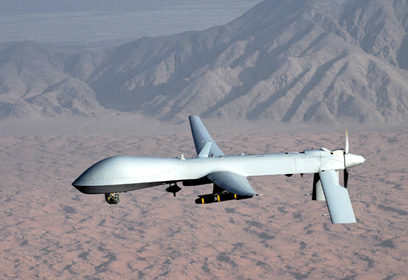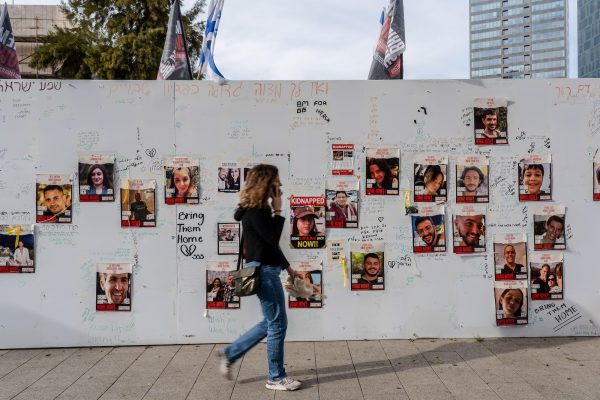Two important events in the confrontation between the Islamic State and the West occurred on November 12 and 13. Although overshadowed by the Paris atrocities, they warrant our attention. On November 12, Mohammed Emwazi (“Jihadi John”) was killed by a drone missile in the Syrian city of Raqqa, in a joint U.S.-British operation. On November 13, the commander of IS in Libya, an Iraqi national called Abu Nabil (also known as Wissam Najm Abd Zayd al Zubaydi), was killed by a U.S. air strike. These two high-profile killings were part of an ongoing American campaign to systematically assassinate terrorist leaders—“high-value targets”—a strategy that has become a central component of the War on Terror.
More than ever, it is crucial to debate the political strategy behind such targeted killings. Insofar as there is a political rationale to these acts of remote execution, it is deeply suspect. Even the pragmatic rationale is flawed: the evidence is that targeted killings make us less safe, not more.
The policy of assassinating high-value targets, modeled after Israeli practices, was adopted in the early days of the U.S. War on Terror but escalated by the Obama Administration with the aid of drone technology. Advocates describe it as an efficient way of killing terrorists that poses minimal risk to service members and entails much lower collateral damage than do conventional attacks. Most of the controversy around targeted killing has concerned the legality of using lethal means outside of war zones and the numbers of civilians killed in these strikes. Another source of worry is what will happen when—inevitably and soon—other countries obtain the technology of remote assassination. U.S. actions will as precedents for these other powers.
These are valid concerns, but there are others, even more basic. We should question the logic of the drone in the first place. Is it actually wise? Let us assume that those killed—such as Jihadi John and Abu Nabil—are indeed guilty of horrendous crimes, are planning further such crimes, and that mounting conventional operations to kill or capture them would not be feasible. The question remains, is it an effective strategy to assassinate the leaders of extremist, terrorist, or criminal organizations? It is one thing to kill a terrorist commander during a police or military operation, such as hot pursuit or breaking a siege. It is quite different to elevate killing extremists from tactical combat necessity to guiding strategic principle.
The Israelis are quite sure that targeted assassination is a good idea. Counter-terror expert Daniel Byman put it this way:
After the second Intifada broke out in September 2000, Israel dramatically stepped up its targeting of Palestinian terrorists, killing more than 200 of them. This campaign worked. Targeted killings—combined with the security barrier, military operations and improved intelligence—reduced Israeli deaths from a high of 172 in 2002 to less than 40 in 2005. Even more telling, this decline in deaths occurred during periods when the number of attempted attacks by Hamas increased, suggesting that the organization became less capable even though its hatred did not diminish.
But Byman misleads us with his categorical conclusion that “this campaign worked.” Other experiences are salutary.
In Kill Chain (2015), a thorough and fascinating look at American targeted killing, Andrew Cockburn describes how, following the invasion of Iraq, the United States initially adopted the approach of seeking out the most prominent leaders of armed opposition—first Saddam Hussein himself, then Abu Musab al Zarqawi. The assumption, in the words of one military officer, was that “if you lop the head off a snake, the snake’s not going to be so viable after that.”
The problem, as the U.S. army soon discovered, was that the resistance was not like a snake; it was like a hydra. The theory of decapitation didn’t work. Zarqawi’s deputy and successor, Abu Ayyub al Masri, was even more dangerous.
This was the wider experience in Iraq, as well. Cockburn quotes Rex Rivolo, a defense analyst, who talked to U.S. soldiers to discover whether the high-value targeting was working.
When the topic of conversation came round to ways of defeating the [roadside] bombs, everyone was in agreement. ‘They would have charts up on the wall showing the insurgent cells they were facing, often with the names and pictures of the guys running them,’ Rivolo remembers. ‘When we asked about going after the high-value individuals and what effect it was having, they’d say, “Oh yeah, we killed that guy last month, and we’re getting more IEDs than ever.” They all said the same thing, point blank: “[O]nce you knock them off, a day later you have a new guy who’s smarter, younger, more aggressive and is out for revenge.”’
The U.S.-African campaign against the violent extremist group al Shabaab in Somalia followed a similar pattern: each dead leader is followed by a more radical deputy. After a failed attempt in January 2007, the United States killed al Shabaab’s commander, Aden Hashi Farah Ayro, in a May 2008 air strike. Ayro’s successor, Ahmed Abdi Godane (alias Mukhtar Abu Zubair), was worse, affiliating the organization with al Qaeda. The United States succeeded in assassinating Godane in September 2014. In turn, Godane was succeeded by an even more determined extremist, Ahmad Omar (Abu Ubaidah).
It is quite possible that—as with Hamas—killing al Shabaab’s leaders degraded the insurgents’ military capability. But it is certain that it didn’t hasten a political resolution to the conflict.
The remote execution of extremist commanders has become routine. Each individual instance can be explained as punishment for atrocities (i.e., revenge) or as preventing a future atrocity, the details of which are kept secret from the public. But what justifies the practice at scale? What is the political strategy that underpins repeatedly decapitating the hydra?
Byman and Avi Dicter—former head of Israel’s internal security service, Shabak—explain what they call the basic principles of Israeli counter-terrorism:
First, the number of effective terrorists is limited: there is a bottom to the barrel of skilled terrorists. Although the number of potential recruits for a popular cause such as Palestinian terrorism or the Sunni jihad against the United States may be large, the number of generators of terror is limited. Generators of terror are the skilled operators who provide the organizational framework and logistics that enable a terrorist organization to be effective.
This is the rationale for targeted killing: the number of terrorists is finite, so it makes sense to kill them one by one. The Israelis marshal statistics, which, they belive, bear out the claim.
One consequence of this is that, as Dicter and Byman admit, hatred intensifies. New recruits—perhaps less experienced and less technically capable, but more radical and more determined—emerge. These men automatically move to the top of the Israeli target list. Another Israeli intelligence chief explained to Cockburn what follows: “All the time we have to mow the grass—all the time—and the leaders with experience will die and the others will be without experience and finally ‘the barrel of terror’ will be drained.”
Naturally, the Dicter philosophy requires that the “barrel of terror” be drained more quickly than it is refilled from the well of resentment.
There are other consequences, too. Cockburn compares targeted political murder with the consequences of Mexican president Felipe Caldéron’s war on the drug cartels, which took out two-thirds of the most wanted kingpins between 2006 and 2012. The result: no fewer than sixty smaller but considerably more violent criminal drug groups contested for control of the vacuum. Consider also the repercussions of killing Muammar Gaddafi, the kingpin of mercenaries in the Sahara, whose removal spawned violent competition by his former lieutenants over a domain stretching from Libya to Mali.
Any political leader—in Washington, Tel Aviv, or Mogadishu—who seeks a political settlement to a conflict involving terrorism needs someone with whom to negotiate. It is no good to negotiate with one’s friends or pretend that building state institutions can substitute for a process of talking to the enemy. And the best intermediary is experienced, a known quantity.
The British seemed to recognize this in their conflict in Northern Ireland. U.K. secret services could have assassinated the leaders of the IRA, including Gerry Adams and Martin McGuinness. They knew who they were and where they were, and they could have made it look like an accident or an internecine murder. They decided not to. It was a wise decision: those men ultimately decided to talk peace.
Dicter and Byman’s sixth principle of counter-terrorism is that “arrests, targeted killings, and defensive measures are means of managing a conflict, not means of solving it. . . . A lasting settlement to the Israeli-Palestinian conflict requires a political settlement.” They argue that terrorism must be halted first, and then political negotiations can begin. They do not consider the argument that “mowing the grass” means that interlocutors for peace simply don’t exist; they are either dead or demoralized.
Indeed, the states that terrorists call home seem to understand what the theorists of targeted killing do not. Many of the world’s most dangerous terrorists are in the Greater Middle East, in countries where politics have become thoroughly marketized, the practice of bidding for loyalties with material rewards the norm. The intelligence services of Arab countries tend to operate on the marketplace principle: they assume that anyone can be bought, or at least rented. Their reluctance to murder violent extremists causes no little frustration in Washington and Tel Aviv. But there is a logic behind this caution. It is an elite truce, based on the principle that in a turbulent political system, just as today’s friend can be tomorrow’s enemy, so too could today’s enemy be tomorrow’s ally.
That elite truce holds, more or less, in countries such as Sudan. It held in Somalia until about 2005, when the CIA began clandestine “snatch and grab” operations targeting Islamist commanders for rendition—a practice described by Matt Bryden, former coordinator of the UN Monitoring Group on Somalia and Eritrea, as “a stupid idea.” The tacit elite truce was broken, and the Islamists responded with the country’s first suicide bombings. The first U.S. combat operations in January 2007 were air strikes on convoys suspected to include al Shabaab leaders and al Qaeda members. Al Shabaab escalated with a campaign of elite murders of a nature that Somalis hadn’t seen for fifteen years: attempts to kill parliamentarians, artists, and other members of the country’s elite.
Jihadi John was a criminal, but his execution was no more than a symbolic gesture to show that the British and American governments are acting tough. Abu Nabil was not only a criminal but a criminal leader, and his death may reduce the Islamic State’s military capabilities in Libya. But his assassination, in the absence of a political strategy for resolving the challenge of IS, is just another turn of the blades. If targeted killing remains a central strategy of the War on Terror, it is set to be an endless war.







